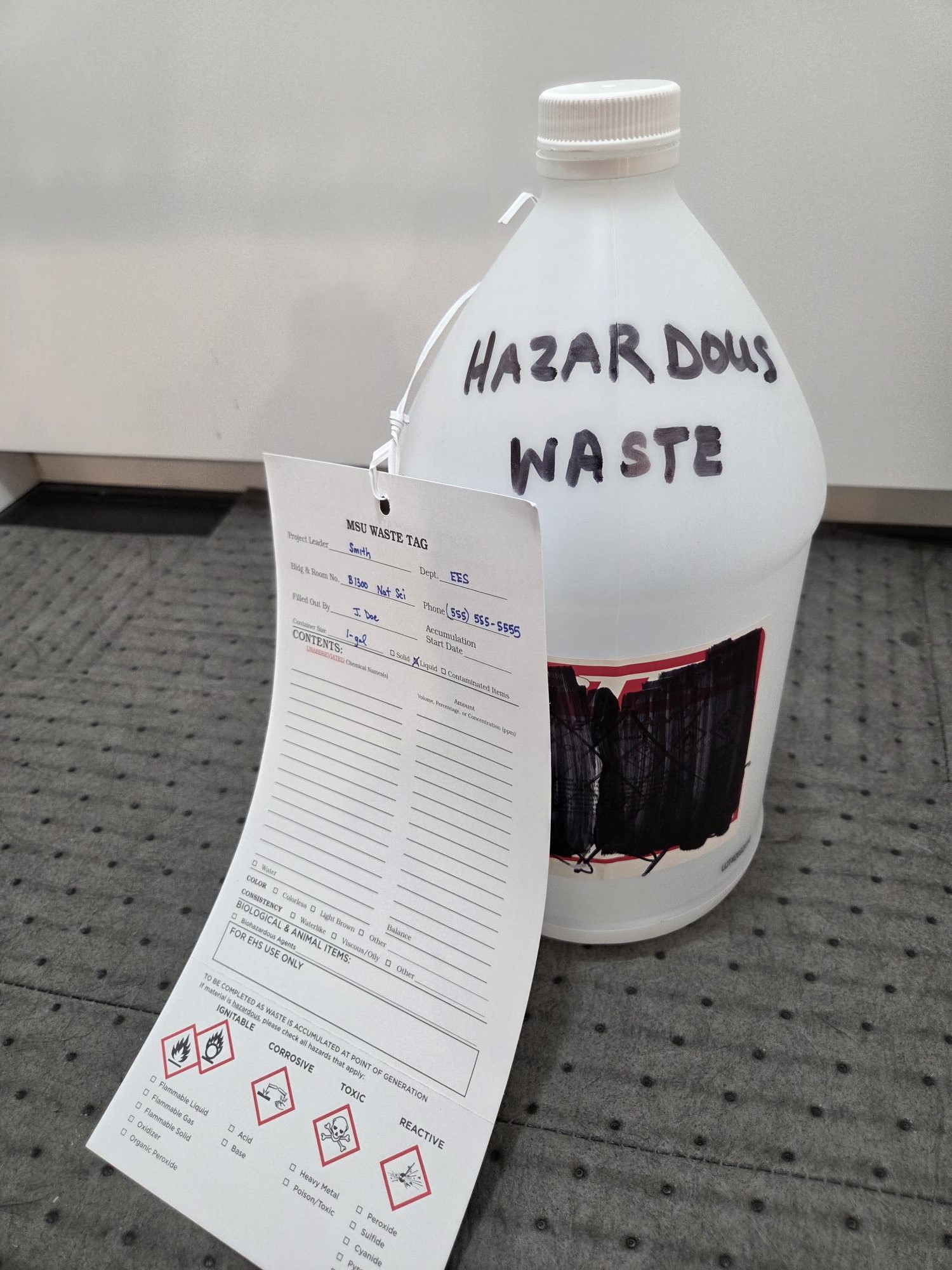Empty Bottles and Containers
Definition
A wide variety of chemical reagents and products are utilized across campus for research, maintenance, agriculture, custodial, and clinical purposes. The USEPA defines an empty container as one previously containing non-acute hazardous waste with all material removed so that no more than 1-inch of material or no more than 3% by volume remains. Any chemical containers that do not meet this definition are required to be disposed of through the EHS Hazardous Waste Program if not reused for waste collection.
There are two options for disposal of chemical containers at MSU:
Empty Containers for Disposal
Proper disposal for empty reagent bottles and containers depend on the type of chemical previously stored:
Drums
All drums should be submitted for disposal to the EHS Hazardous Waste Program regardless if they are empty or if there is product remaining in the container. Please note, the lid or cap must be on the drum in order for EHS to be able to accept the container for disposal.
5-gallon metal containers
Containers that previously held various solvents should be submitted for disposal to the EHS Hazardous Waste Program. Please note, the lid must be on the container in order for EHS to be able to accept the container for pick up.
P-Listed Chemicals
If your chemical is on this list (eCFR :: 40 CFR Part 261 -- Identification and Listing of Hazardous Waste), the bottle must be triple rinsed and the rinsate collected in a hazardous waste container prior to disposal in the general refuse. Empty glass bottles to be disposed of in the general refuse trash must be either be in broken glass containers, or some other sealed, rigid container to prevent a cut injury.
Pyrophoric/Reactive Chemicals
Empty and unwanted pyrophoric and reactive reagent containers should be disposed of as hazardous waste and must not be reused as a waste container. Do not quench the material, remove the seal, or puncture the septum. Ensure the container is in good condition, including the cap, and is labeled as to its contents. Wrapping the outside of the cap with a layer of Parafilm is also recommended. If you are concerned about the integrity of the container do not remove any questionable containers from an inert atmosphere glovebox and contact EHS Hazardous Waste Staff to consult prior to requesting a pickup.
In addition, if you are disposing of any of the following pure alkali metals or alkaline earth metals, materials must be under mineral oil prior to EHS picking up the material: Sodium, Potassium, NaK, Lithium, Cesium, Rubidium, Francium, Beryllium, Magnesium, Calcium, Strontium, Barium, Aluminum, and Zinc.
Solvents
If your chemical is a solvent, the empty container can be air dried in the fume hood until odor free, and once the label is defaced, it can be disposed of in the general refuse with the cap off. Empty glass bottles to be disposed of in the general refuse trash must be either be in broken glass containers, or some other sealed, rigid container to prevent a cut injury.
Other
If your material is not listed above, the container can be rinsed with a slight amount of water and collected in a waste container. The bottle can then be defaced and put in the general refuse with the cap off. Empty glass bottles to be disposed of in the general refuse trash must be either be in broken glass containers, or some other sealed, rigid container to prevent a cut injury.
Empty Containers Reused For Waste Collection
Once reagent bottles have been properly cleaned out per the instructions above, they can be utilized for waste collection (if appropriate for reuse) after completing the following steps:
- Ensure the container previously held the same state of matter as your waste. In general, containers that held solids should not be used for liquid waste as they lack the proper gaskets to prevent a leak.
- Ensure the container is compatible with the waste you will be generating. There are some corrosive/oxidizing solutions that cannot be placed in a glass bottle. Refer to the Corrosives specific guidance document for information on these specific solutions.
- Completely deface the entire label of the bottle either by removing the label, or completely blacking out with a Sharpie. The previous chemical name and GHS symbols should not be visible.
- Attach a MSU Waste Tag with a twist tie, tape, or string to the container. The waste tag must be physically attached and not sitting next to the container.
- Either write the words “Hazardous Waste” on the container or print off a Hazardous Waste label from the EHS website (https://ehs.msu.edu/waste/managing-chemical-waste.html) and affix it to the bottle.
MSU Waste Tag Required
Yes - A MSU Waste Tag is needed for empty containers being reused for waste disposal.
No - A MSU Waste Tag is not needed for empty containers being submitted for disposal.
Labeling
Empty containers submitted for disposal through the EHS Hazardous Waste Program should have intact, legible manufacturer’s labels that identified the previous contents.
Submit Hazardous Waste Request
Uncontaminated glassware and broken glassware with fixed materials can be placed in the general refuse trash once the container has been properly sealed and labeled.
When the container for broken glassware with unfixed materials or chemical contaminated glass is full or close to the 90-day accumulation limit, submit a Hazardous Waste Request via the EHS Safety Portal as follows:
- EHS Website: ehs.msu.edu
- Log in into the Safety Portal through a preferred web browser using your MSU Net ID and EBS Password
- Select Hazardous Waste Request
- Empty Bottles/Containers can be found under the Waste Container category


